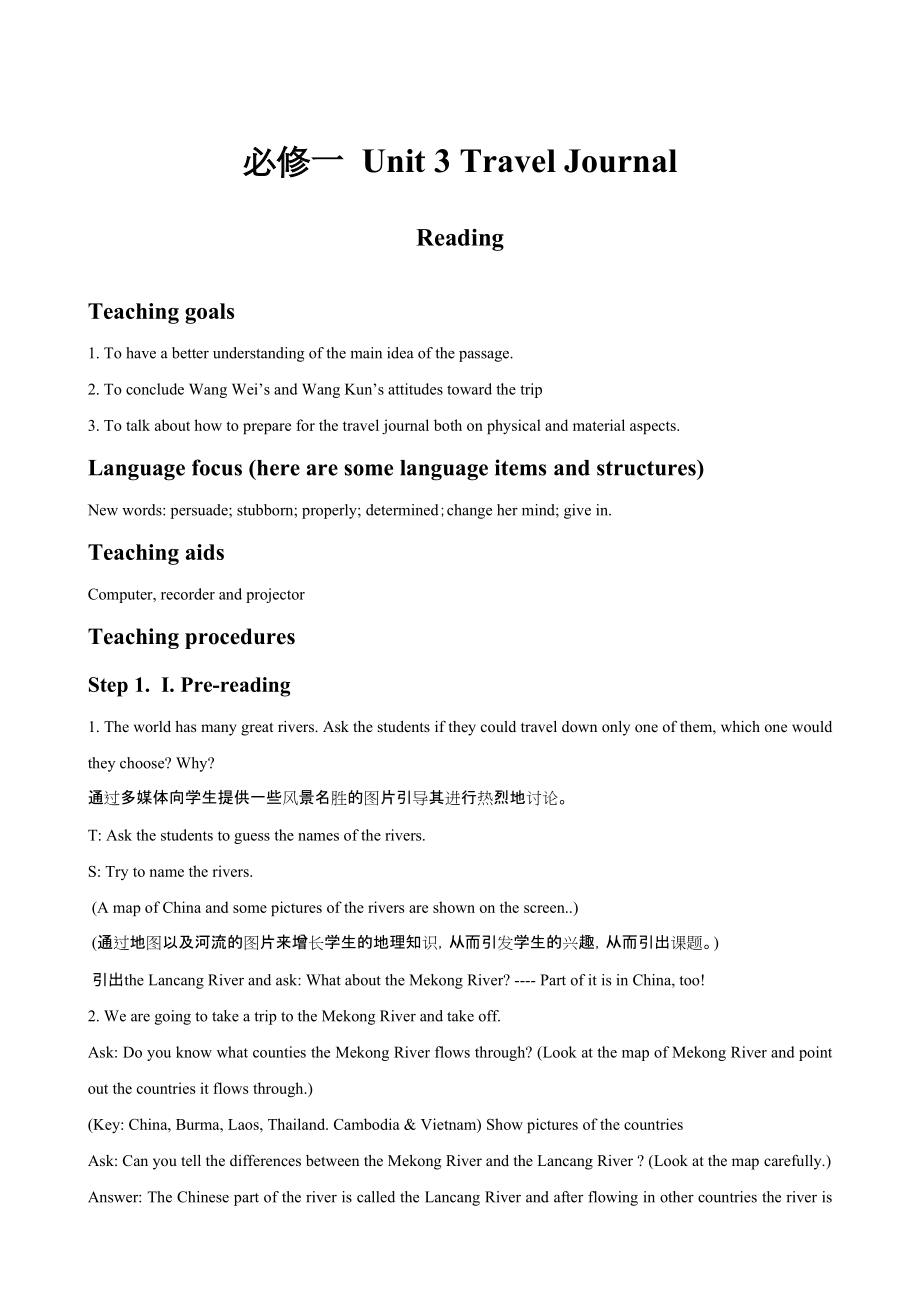《高中英語人教版必修1教案: Unit 3 Travel Journal Reading 教案5 Word版》由會員分享,可在線閱讀�����,更多相關(guān)《高中英語人教版必修1教案: Unit 3 Travel Journal Reading 教案5 Word版(3頁珍藏版)》請在裝配圖網(wǎng)上搜索����。
1、 精品資料
必修一 Unit 3 Travel Journal
Reading
Teaching goals
1. To have a better understanding of the main idea of the passage.
2. To conclude Wang Wei’s and Wang Kun’s attitudes toward the trip
3. To talk about how to prepare for the travel journal both on physical and
2���、 material aspects.
Language focus (here are some language items and structures)
New words: persuade; stubborn; properly; determined�;change her mind; give in.
Teaching aids
Computer, recorder and projector
Teaching procedures
Step 1. I. Pre-reading
1. The world has many great rivers. Ask the
3���、students if they could travel down only one of them, which one would they choose? Why?
通過多媒體向?qū)W生提供一些風(fēng)景名勝的圖片引導(dǎo)其進(jìn)行熱烈地討論����。
T: Ask the students to guess the names of the rivers.
S: Try to name the rivers.
(A map of China and some pictures of the rivers are shown on the screen..)
(通過地圖以及河流的圖片來增長學(xué)生
4���、的地理知識��,從而引發(fā)學(xué)生的興趣����,從而引出課題。)
引出the Lancang River and ask: What about the Mekong River? ---- Part of it is in China, too!
2. We are going to take a trip to the Mekong River and take off.
Ask: Do you know what counties the Mekong River flows through? (Look at the map of Mekong River and point out the
5���、countries it flows through.)
(Key: China, Burma, Laos, Thailand. Cambodia & Vietnam) Show pictures of the countries
Ask: Can you tell the differences between the Mekong River and the Lancang River ? (Look at the map carefully.)
Answer: The Chinese part of the river is called the Lancang River and
6����、 after flowing in other countries the river is called the Mekong River.
Step 2. Reading
1. Listening
Say: After reaching the Mekong, an old man told us a story about the journey in the Mekong of a boy and a girl .
?T: Ask the students to listen to the tape about the story.
(Before listening,
7�����、 show some new words and expressions: persuade stubborn properly determined change her mind give in)
Listen to the text with 4 questions:
1. Who are Wang Kun and Wang Wei?
2. Who are Dao Wei and Yu Hang?
3. Where it the source of the Mekong River and which sea does it enter?
4. What can you
8�����、 see when you travel along the Mekong?
1).讓學(xué)生聽錄音帶�,邊聽邊找出問題的答案����,從而鍛煉他們的聽力以及他們提取信息的能力。
2).豐富學(xué)生的地理知識�����,對鄰國有更好的理解����。
3).充分發(fā)揮學(xué)生學(xué)習(xí)的主動性���,讓學(xué)生學(xué)會從地圖中提取和綜合信息的能力。
2. Detail reading
Read the text aloud.
Their dream
Taking a great bike trip
Their journey
Finding the source. Along the Mekong River from the sourc
9�����、e .
Their preparation
1.They bought expensive mountain bikes.
2.Wang Wei got their cousins interested in cycling.
3.They turned to the atlas in the library.
The Mekong River
1.begin/glacier on a Tibetan mountain/ small/clean/cold.
2.move quickly/pass through deep valleys
3.half/in China/Lanc
10�、ang River.
4.wide brown and warm/enter
1). Complete the form
2). Fill in the blank
Similar attitudes about the trip
Difference attitudes about the trip
Both Wang Wei and Wang Kun think…
1. taking this trip is a dream that comes true.
2. that they will enjoy this trip a lot.
3. that most of
11、the Mekong will be found in Southeast Asia.
Wang Wei believes…
1. that they must start in Qinghai where the river begins/see all of the Mekong.
2. that they don’t need to prepare much.
Wang Kun believes..
1. it is too cold and high to start in Qinghai.
2. that using an atlas is very importa
12�����、nt.
Students work in pairs to discuss the following open question:
Is it a difficult journey to cycle along the Mekong? Why?
Step 3. Talking
1. Fun time
Imagine that you are helping the cyclists to prepare for their trip down the Mekong. You need to choose what you will take with you.
The foll
13���、owing I will give you something to choose and write down their names as many as possible. (Show pictures)
2.Talking
Ask the students to write down as many words as possible.
This activity requires students to think critically and learn to be resourceful.
Step 4. Summary
In the last minutes, the students are asked to translate some difficult sentences in the passage.
Homework
1. Read the text again and find out the useful words and expressions.
2. Ex 1, 2, 3 on P20.
 高中英語人教版必修1教案: Unit 3 Travel Journal Reading 教案5 Word版
高中英語人教版必修1教案: Unit 3 Travel Journal Reading 教案5 Word版

